
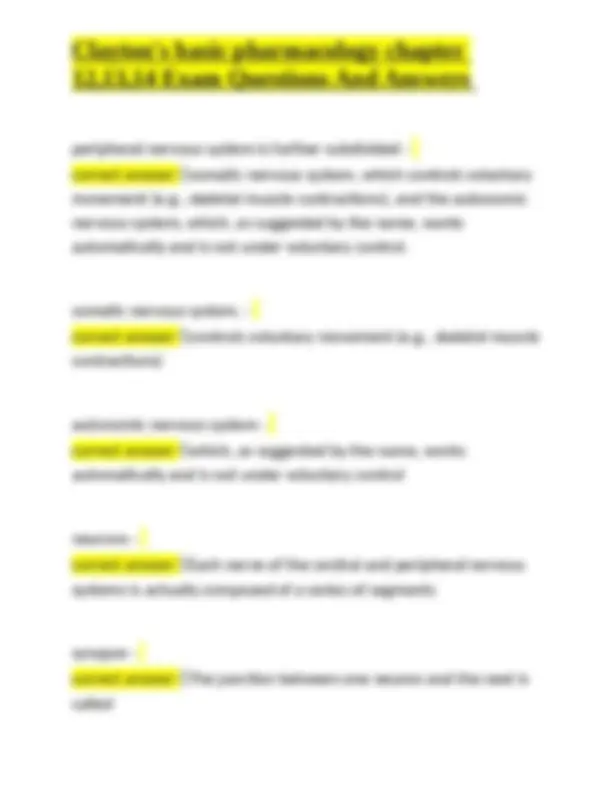
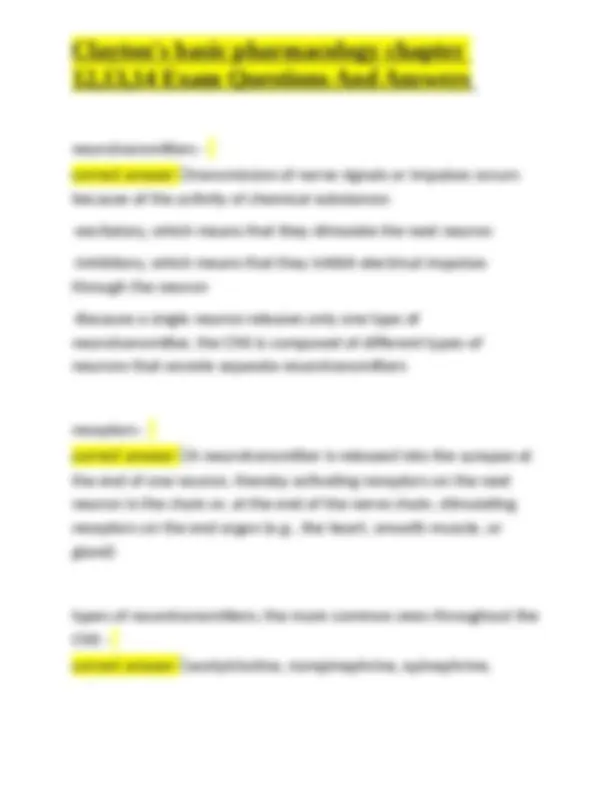
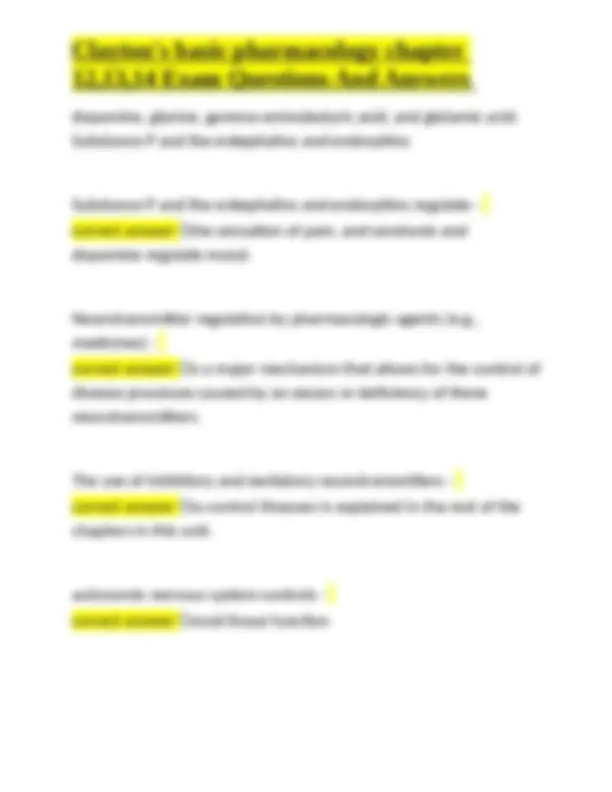
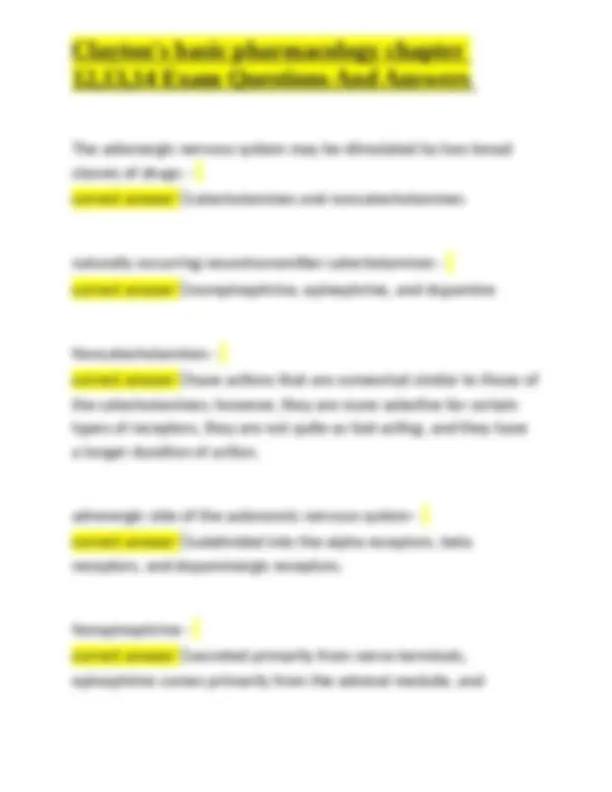
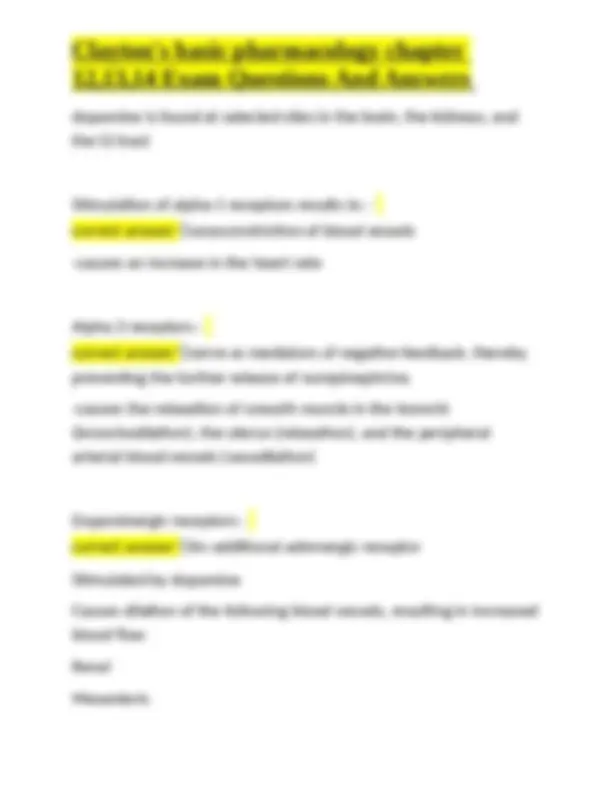
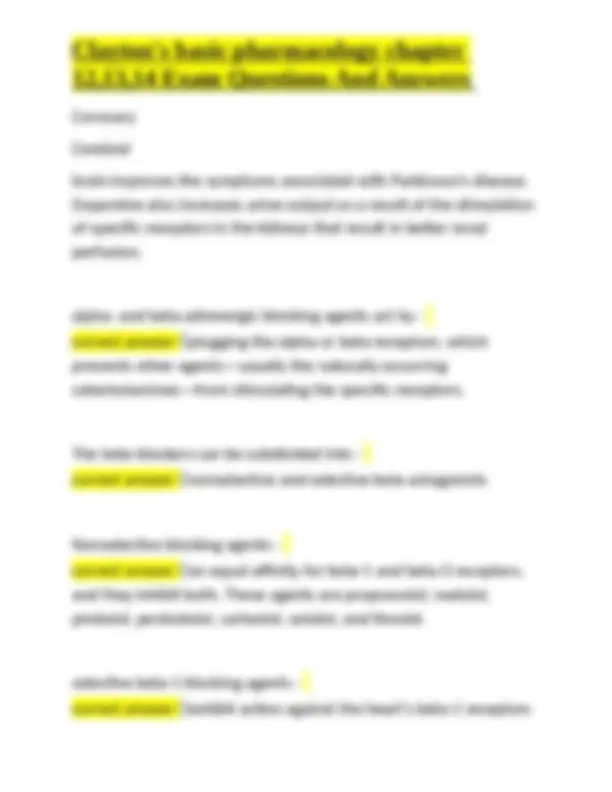
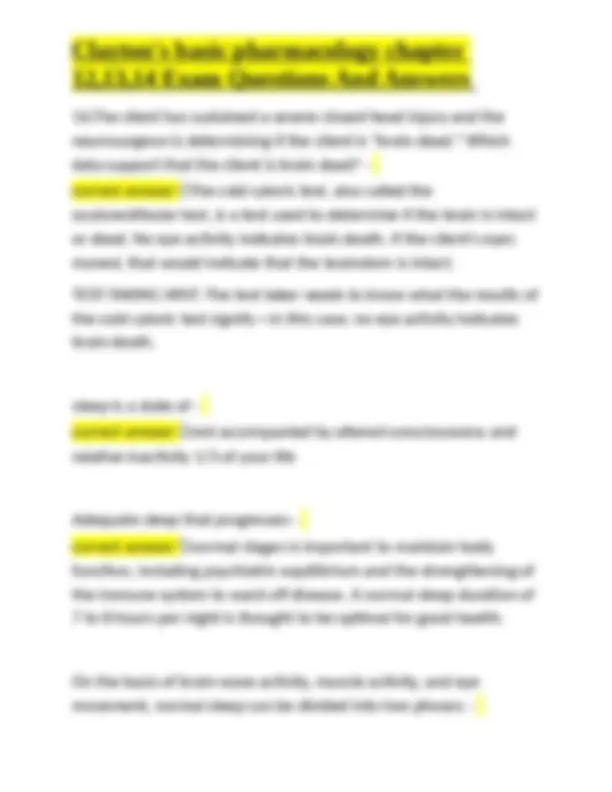
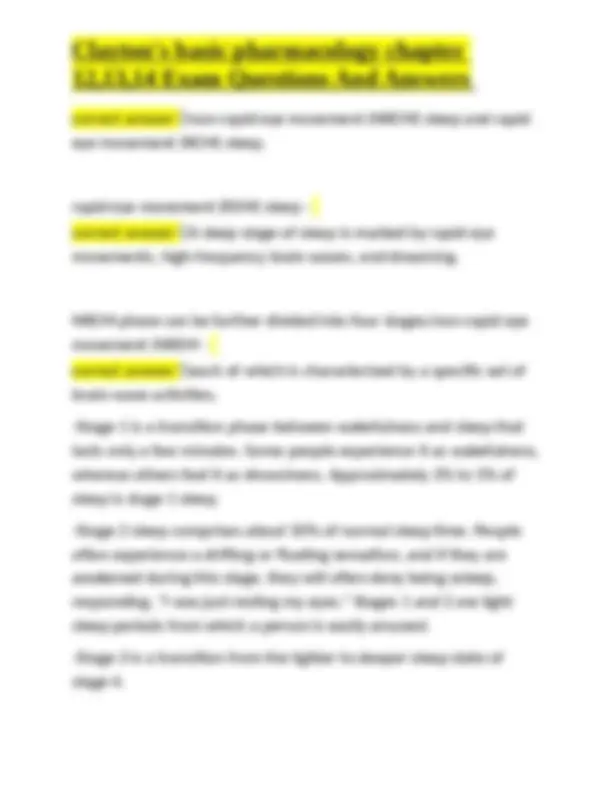
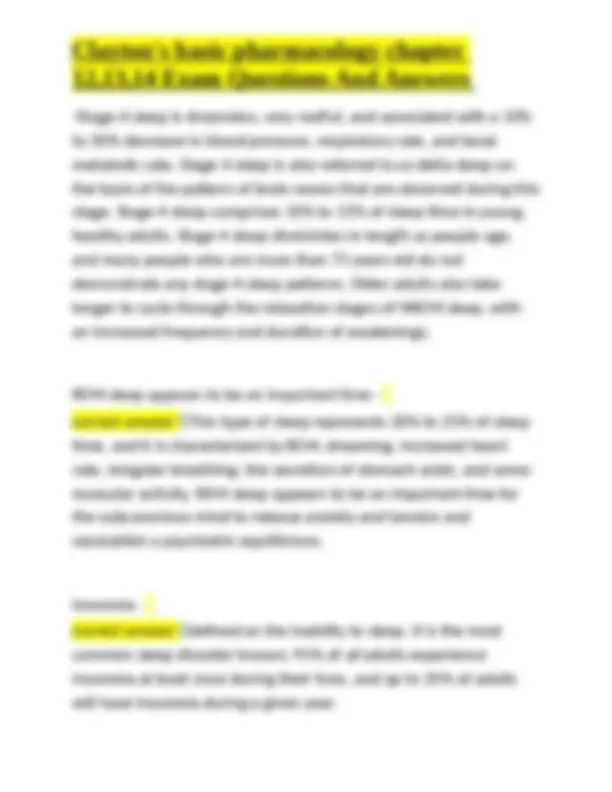
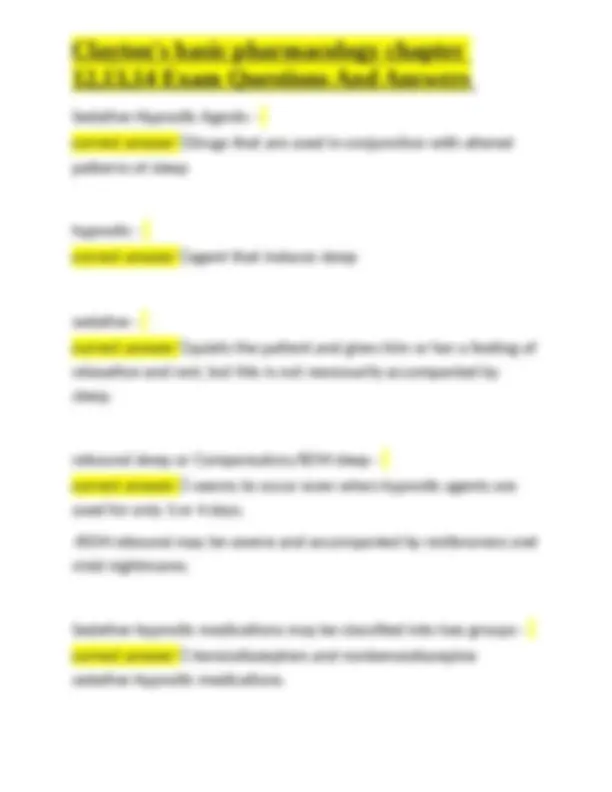
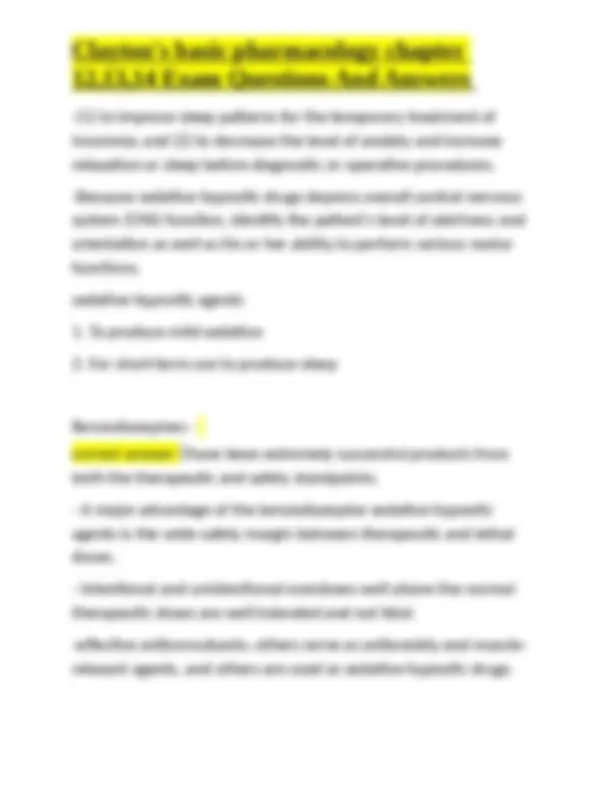
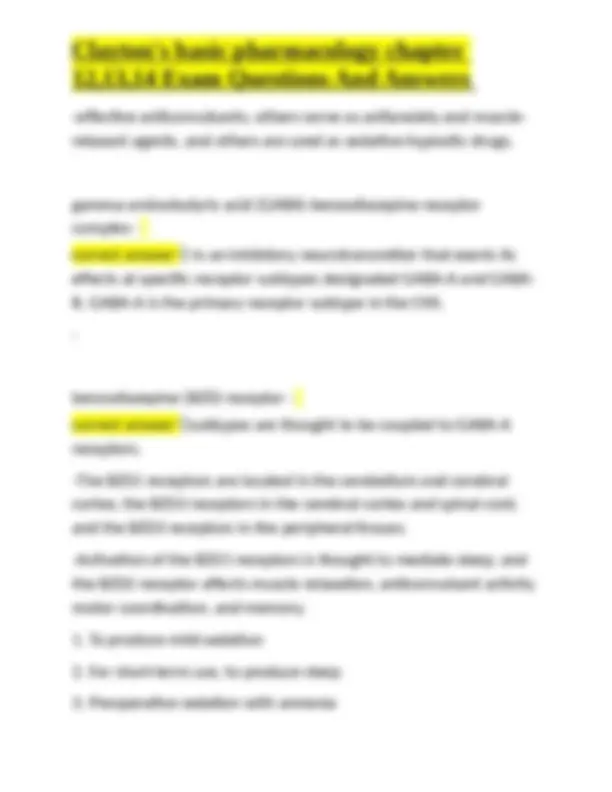
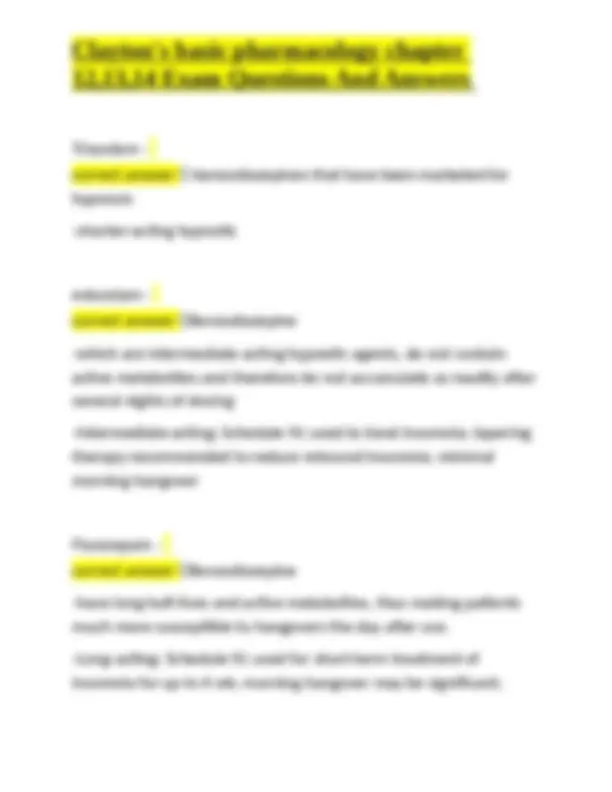
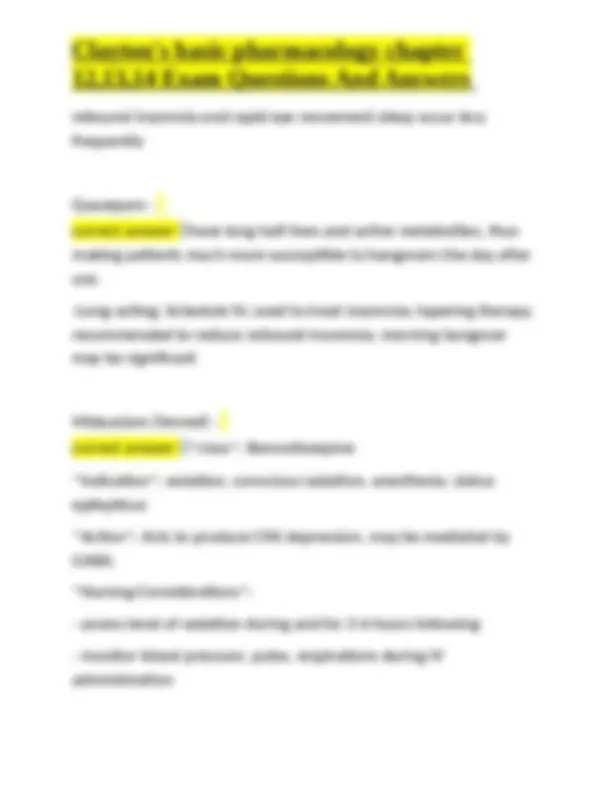
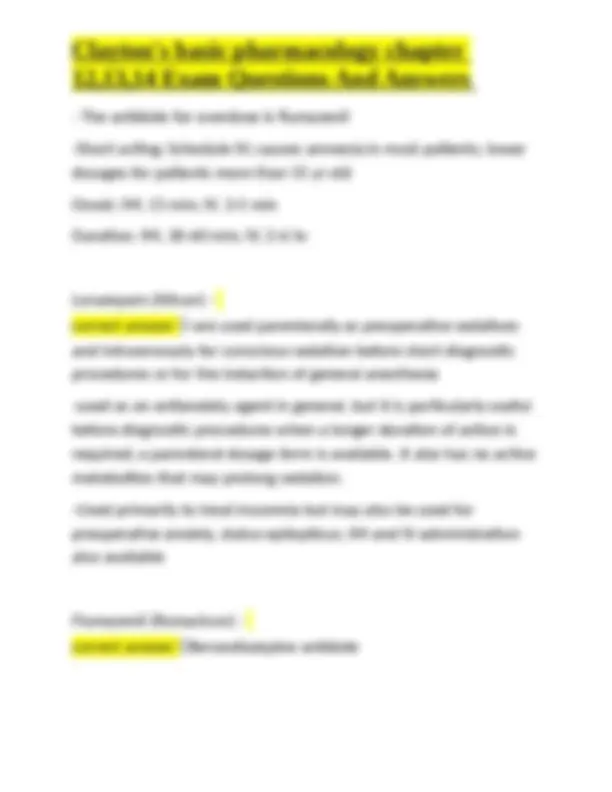
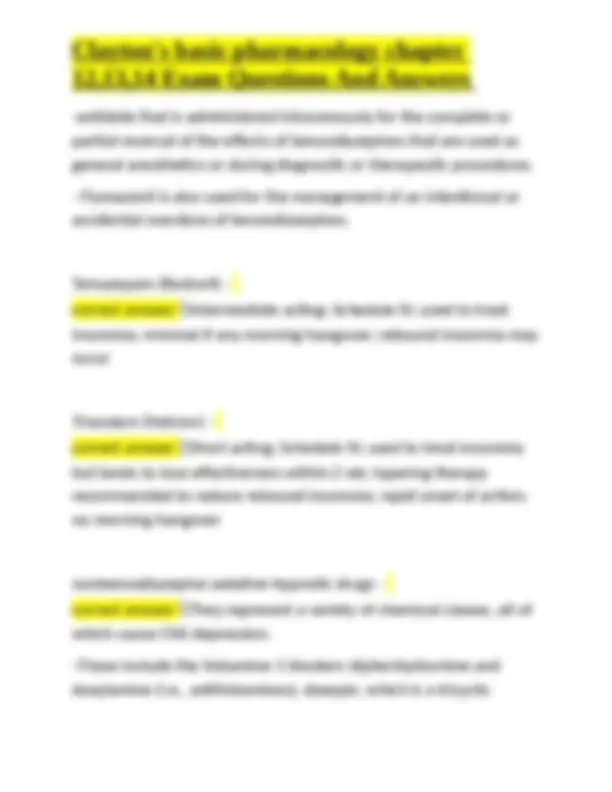
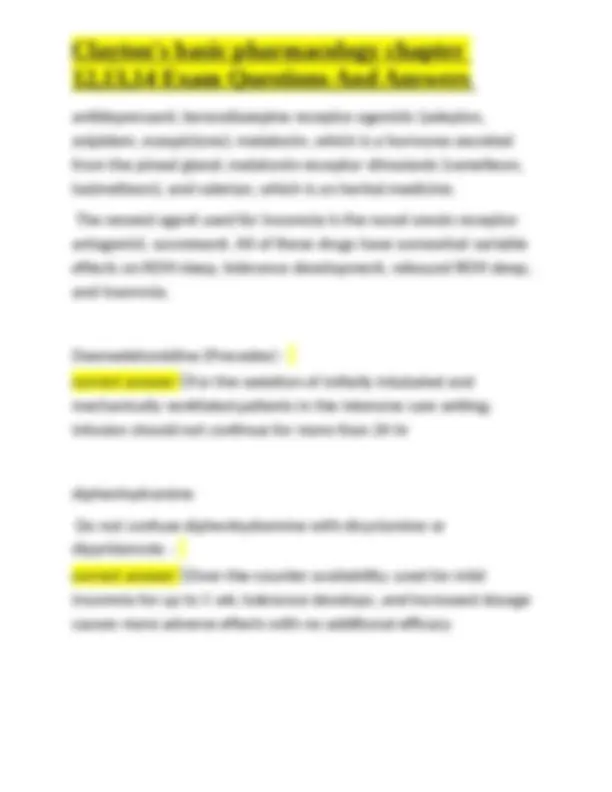
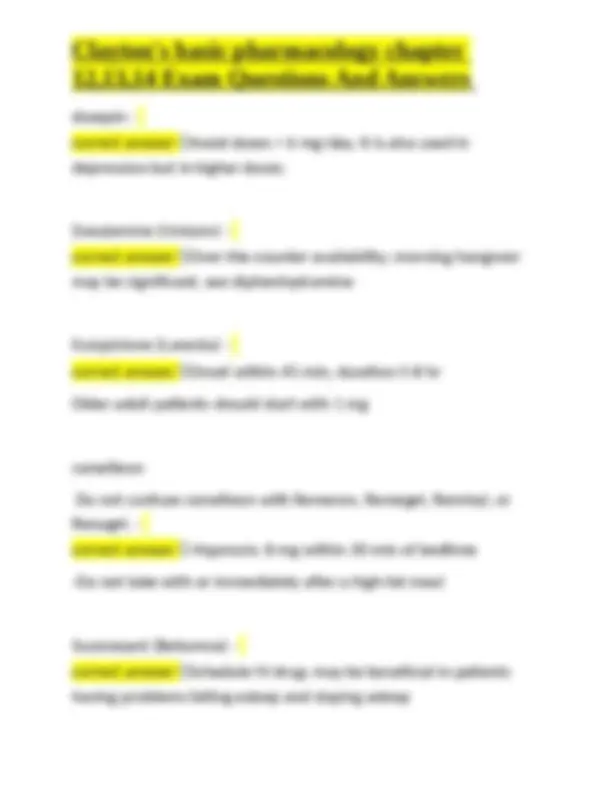
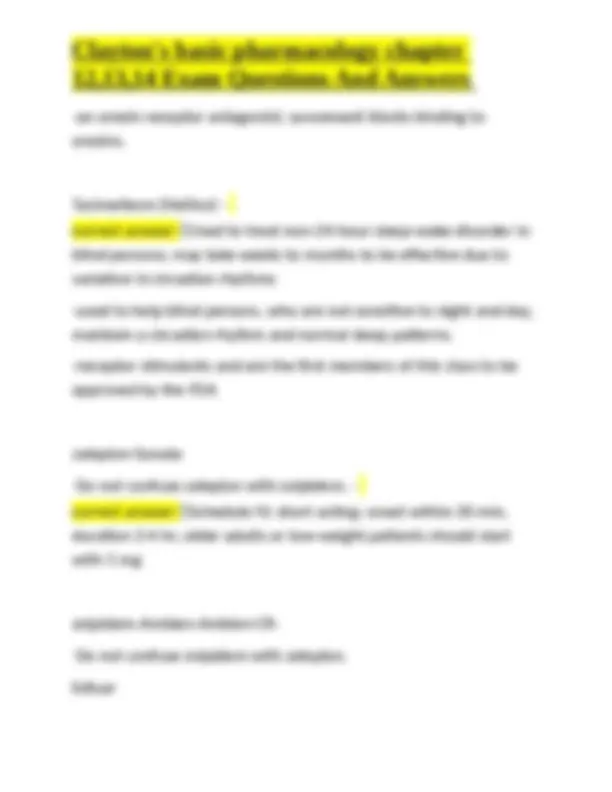
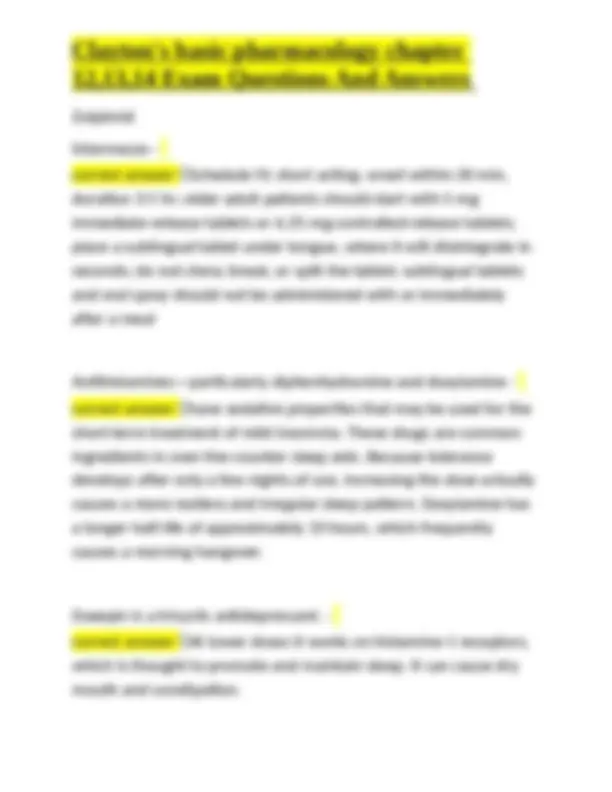
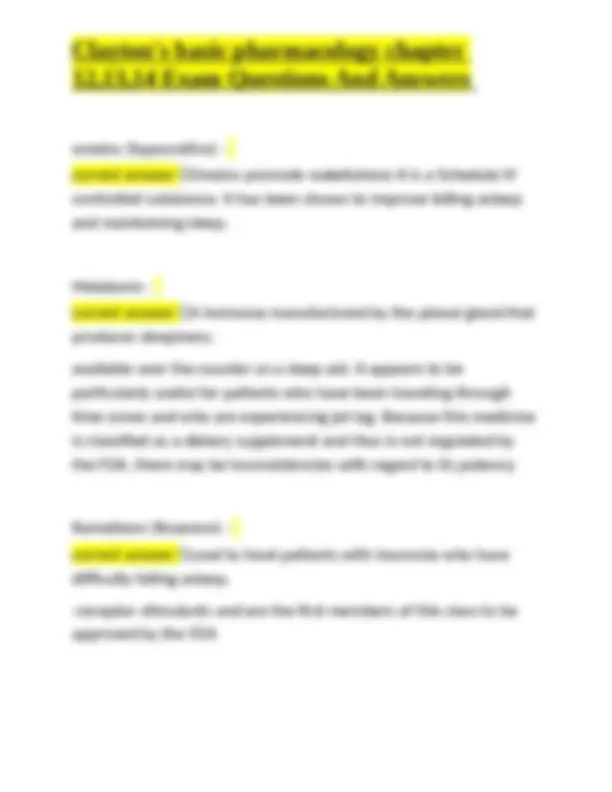
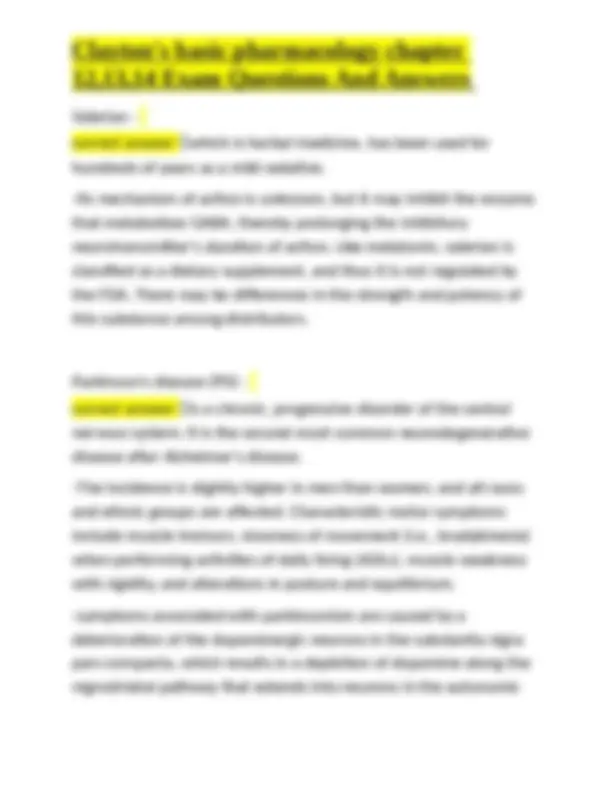
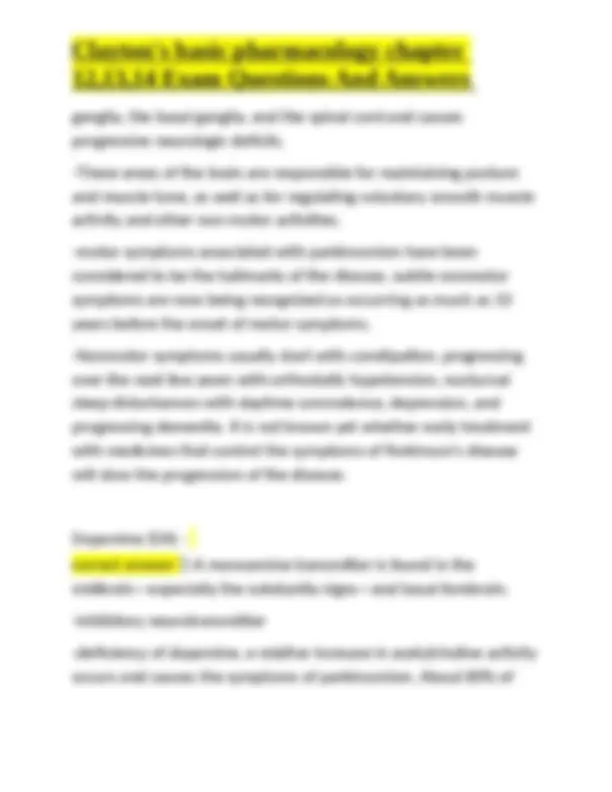
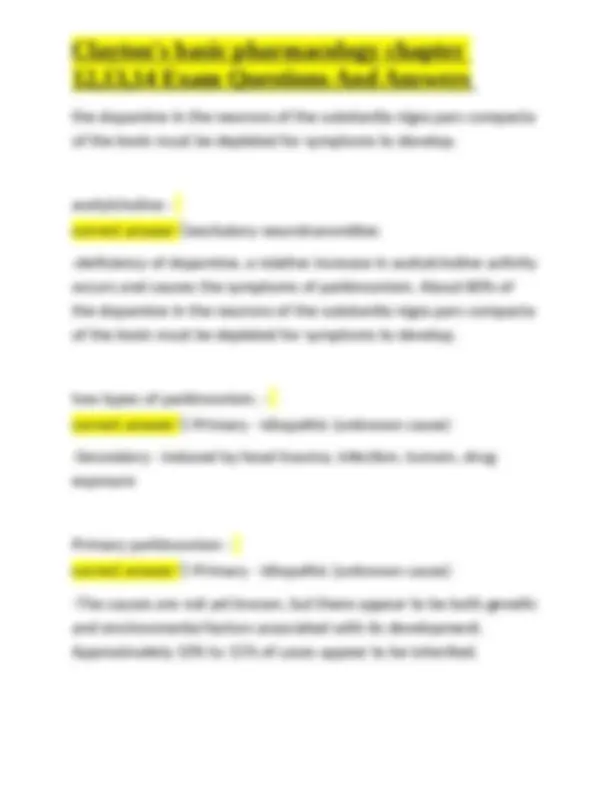
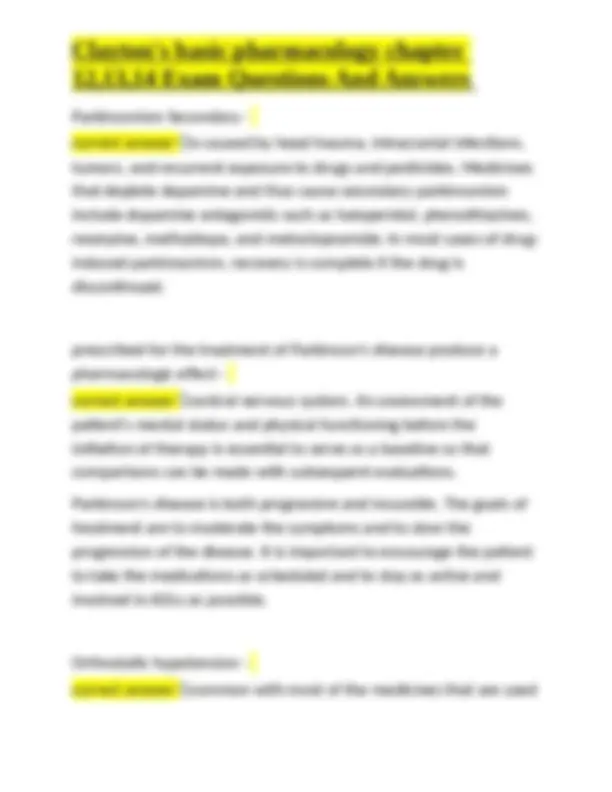
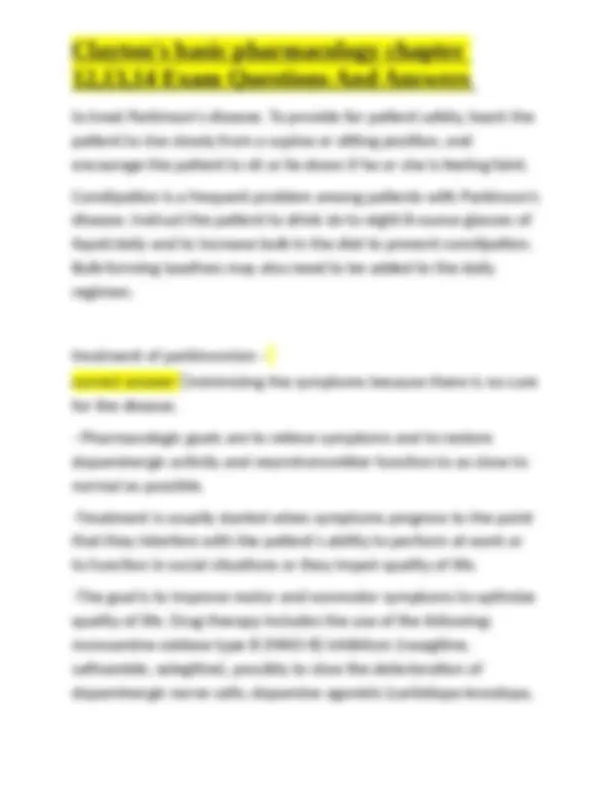
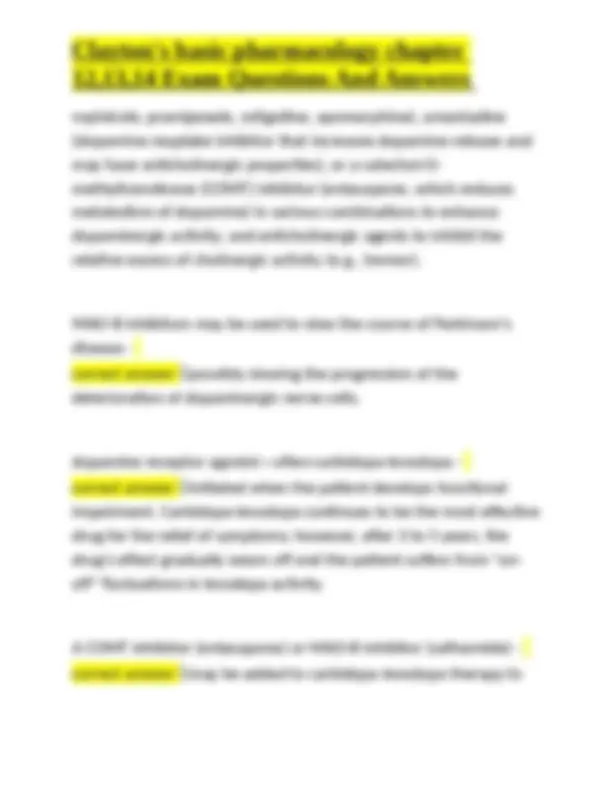
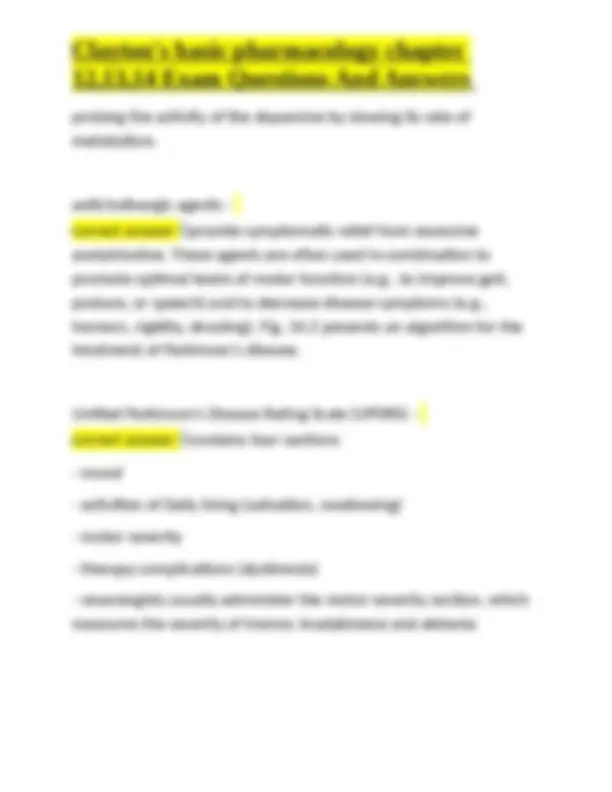
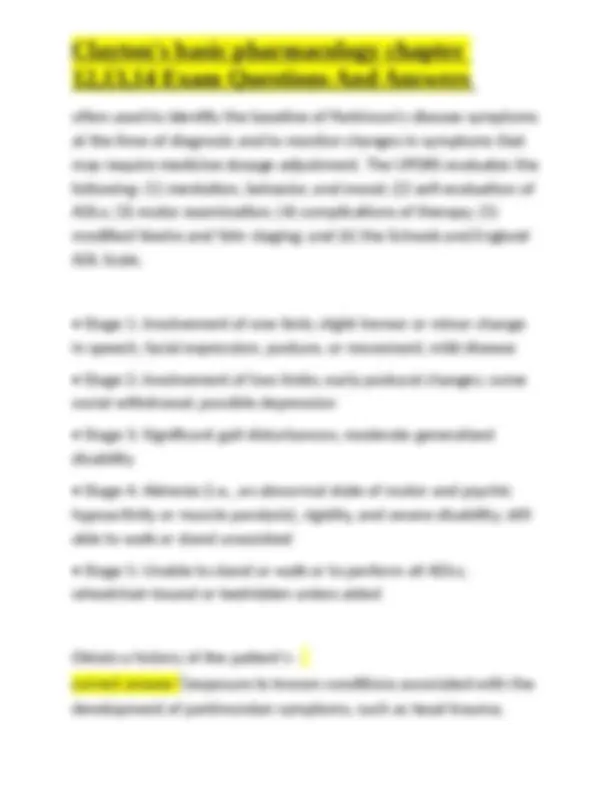
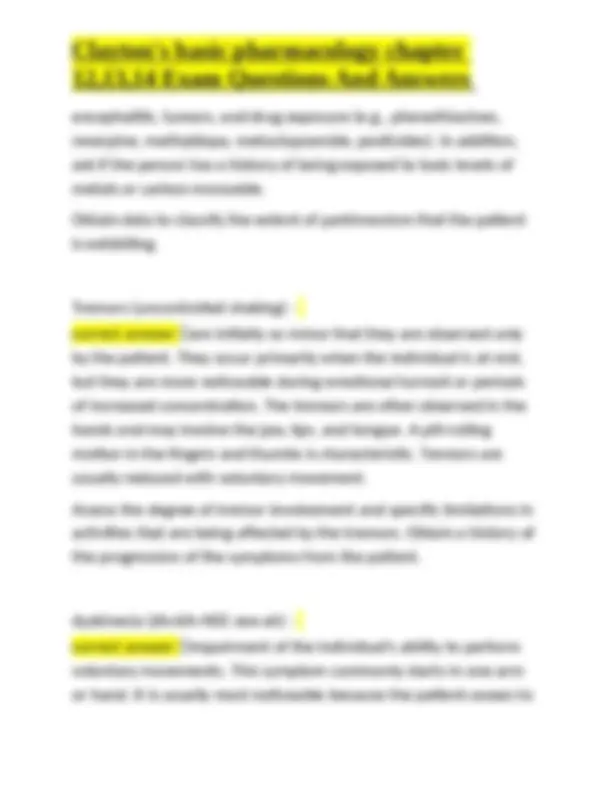
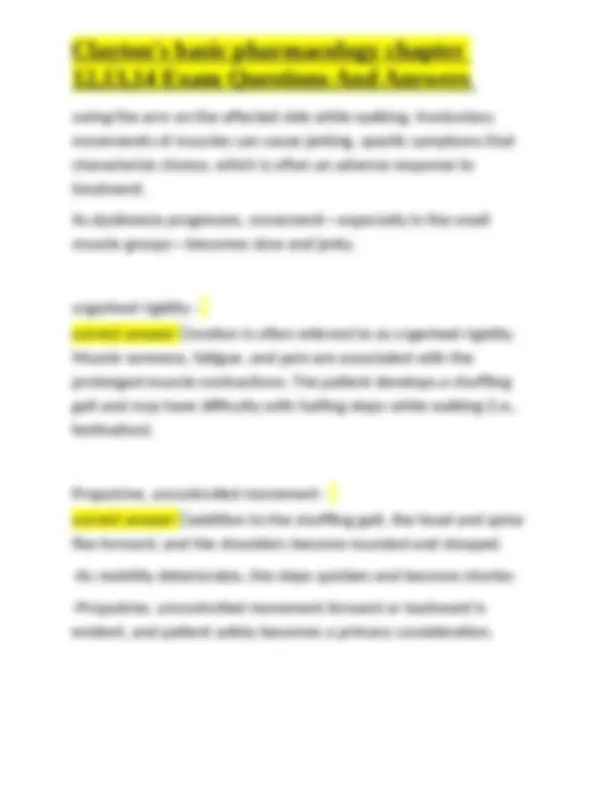
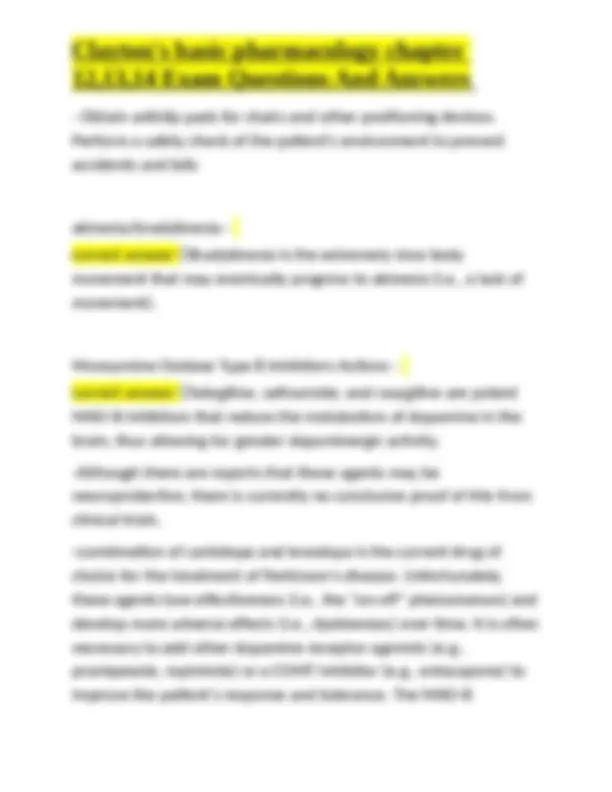
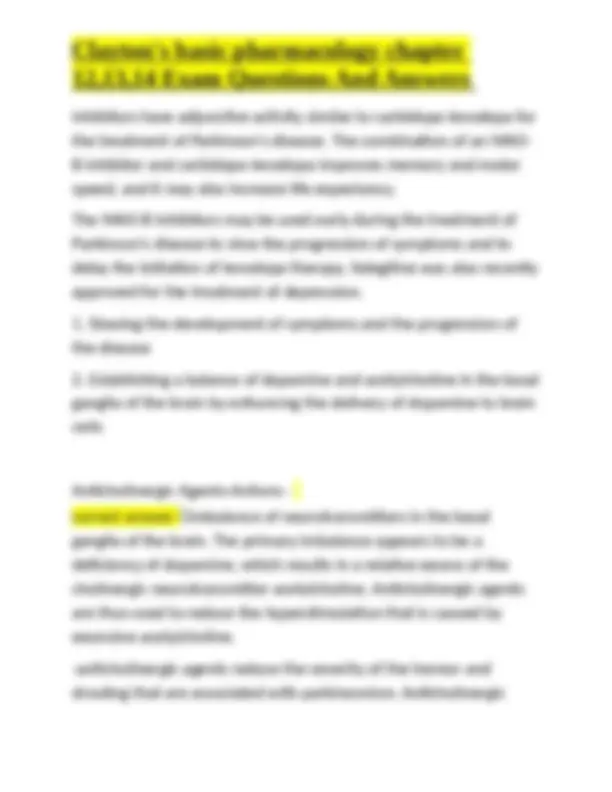
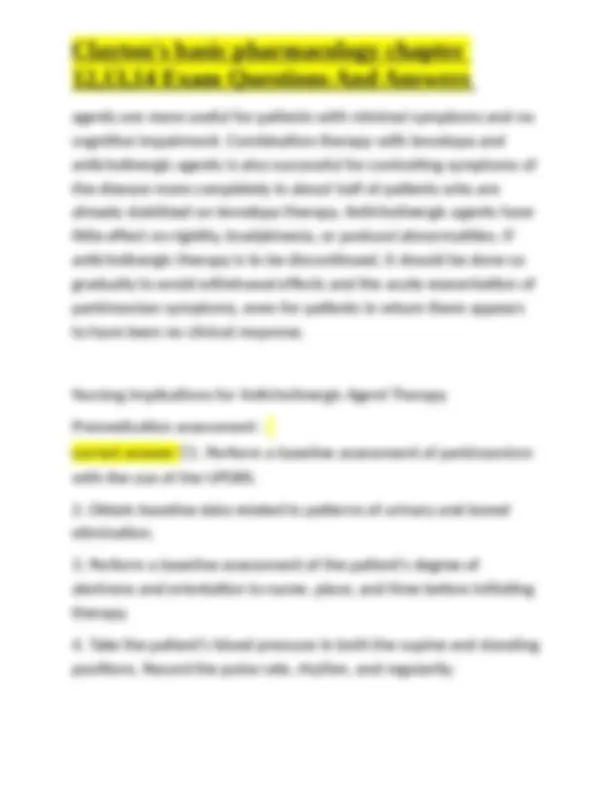
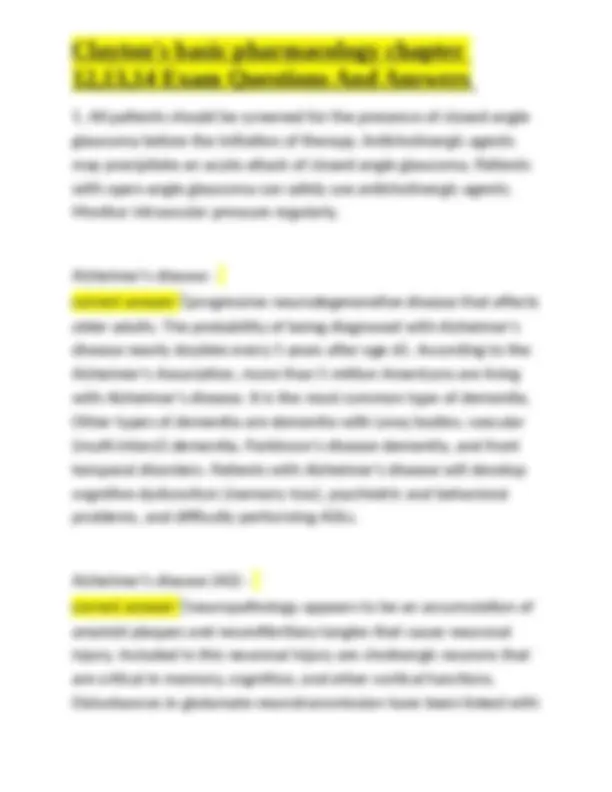
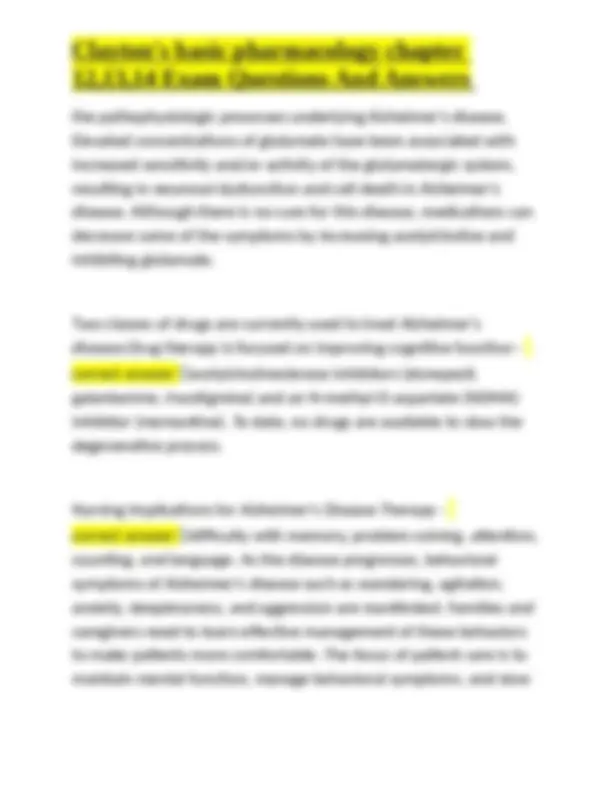
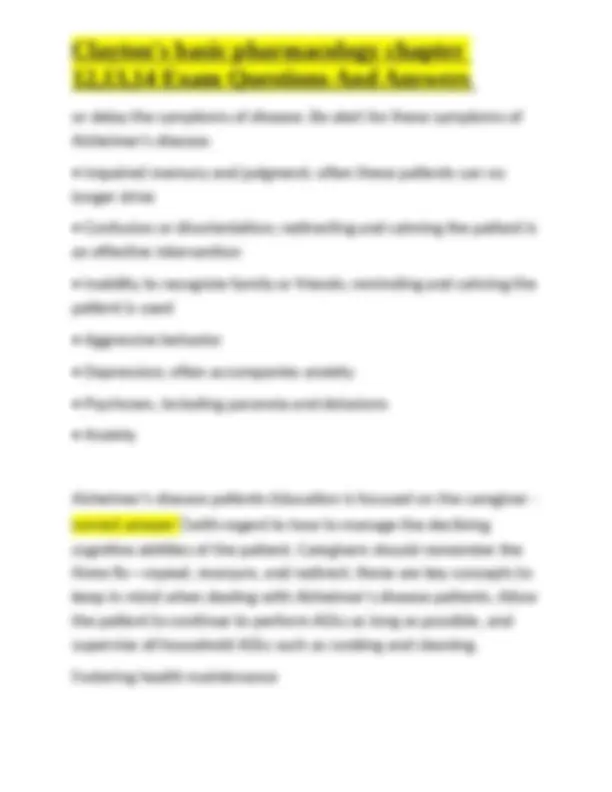
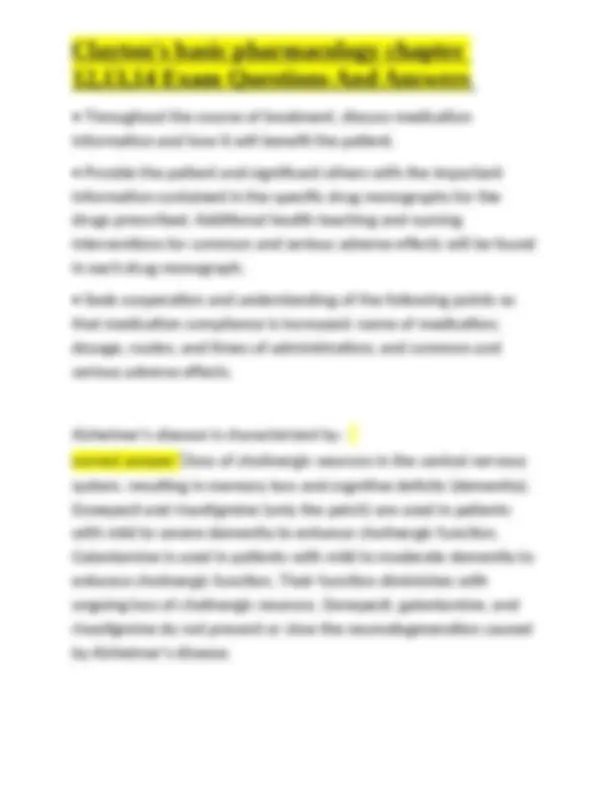
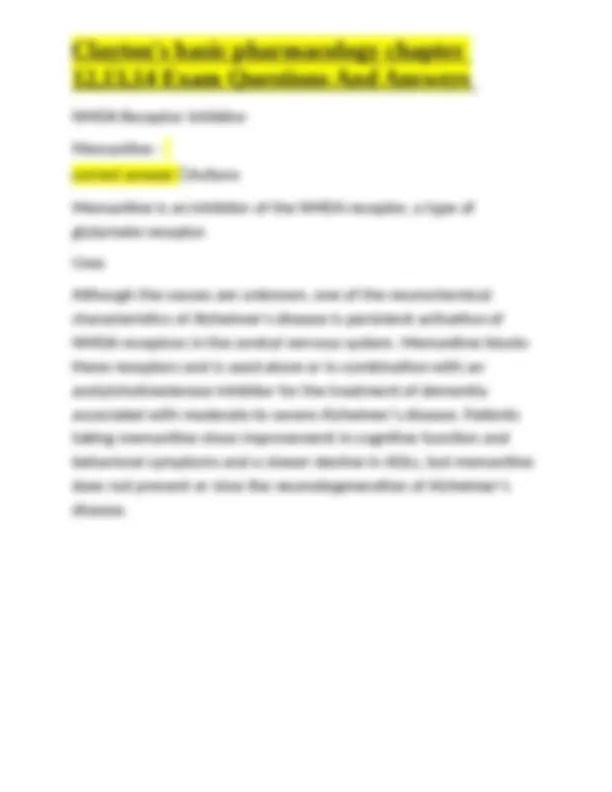


Study with the several resources on Docsity

Earn points by helping other students or get them with a premium plan


Prepare for your exams
Study with the several resources on Docsity

Earn points to download
Earn points by helping other students or get them with a premium plan
Community
Ask the community for help and clear up your study doubts
Discover the best universities in your country according to Docsity users
Free resources
Download our free guides on studying techniques, anxiety management strategies, and thesis advice from Docsity tutors
Clayton's basic pharmacology chapter 12,13,14 Exam Questions And Answers
Typology: Exams
1 / 47

This page cannot be seen from the preview
Don't miss anything!








































indirect-acting cholinergic agents. - correct answer ✅Inhibit breakdown or removal of natural acetylcholine from the acetylcholine receptors Because cholinergic fibers innervate the entire body, effects in most body systems can be expected. Fortunately, because all receptors do not respond to the same dosage, adverse effects are not always seen. The higher the dosage, however, the greater the likelihood of adverse effects The control of the human body as a living organism comes primarily from two major systems - correct answer ✅the nervous system and the endocrine system endocrine system controls - correct answer ✅body's metabolism nervous system regulates - correct answer ✅body's ongoing activities (e.g., heart and respiratory muscle contractions), its rapid response to sudden changes in the environment (e.g., skeletal muscles contracting to help an individual to avoid danger), and the rates of secretion of some glands.
nervous system is composed - correct answer ✅central nervous system (CNS), which is made up of the brain and the spinal cord, and the peripheral nervous system, which includes the peripheral nerves subdivided into the afferent and efferent nerves. central nervous system (CNS), which is made up - correct answer ✅up of the brain and the spinal cord the peripheral nervous system - correct answer ✅includes the peripheral nerves subdivided into the afferent and efferent nerves afferent (peripheral) nerves conduct signals - correct answer ✅from sensory receptors (e.g., vision, pressure, pain, cold, warmth, touch, smell) throughout the body to the CNS efferent nerves of the peripheral nervous system - correct answer ✅The CNS processes these signals and controls the body's response by sending signals back through
neurotransmitters - correct answer ✅transmission of nerve signals or impulses occurs because of the activity of chemical substances -excitatory, which means that they stimulate the next neuron -inhibitory, which means that they inhibit electrical impulses through the neuron -Because a single neuron releases only one type of neurotransmitter, the CNS is composed of different types of neurons that secrete separate neurotransmitters receptors - correct answer ✅A neurotransmitter is released into the synapse at the end of one neuron, thereby activating receptors on the next neuron in the chain or, at the end of the nerve chain, stimulating receptors on the end organ (e.g., the heart, smooth muscle, or gland) types of neurotransmitters; the more common ones throughout the CNS - correct answer ✅acetylcholine, norepinephrine, epinephrine,
dopamine, glycine, gamma-aminobutyric acid, and glutamic acid. Substance P and the enkephalins and endorphins Substance P and the enkephalins and endorphins regulate - correct answer ✅the sensation of pain, and serotonin and dopamine regulate mood. Neurotransmitter regulation by pharmacologic agents (e.g., medicines) - correct answer ✅is a major mechanism that allows for the control of disease processes caused by an excess or deficiency of these neurotransmitters. The use of inhibitory and excitatory neurotransmitters - correct answer ✅to control illnesses is explained in the rest of the chapters in this unit. autonomic nervous system controls - correct answer ✅most tissue function
two major neurotransmitters of the autonomic nervous system - correct answer ✅norepinephrine and acetylcholine. cholinergic fibers - correct answer ✅nerve endings that liberate acetylcholine, -stimulation of cholinergic fibers slows the heart rate adrenergic fibers - correct answer ✅secrete norepinephrine -heart, the stimulation of adrenergic fibers increases the heart rate adrenergic agents or sympathomimetic agents - correct answer ✅Medications that cause effects similar to those produced by the adrenergic neurotransmitter anticholinergic agents - correct answer ✅Agents that block or inhibit cholinergic activity Adrenergic blocking agents - correct answer ✅Inhibit the adrenergic system, preventing stimulation of the adrenergic receptors
The adrenergic nervous system may be stimulated by two broad classes of drugs: - correct answer ✅catecholamines and noncatecholamines naturally occurring neurotransmitter catecholamines - correct answer ✅norepinephrine, epinephrine, and dopamine Noncatecholamines - correct answer ✅have actions that are somewhat similar to those of the catecholamines; however, they are more selective for certain types of receptors, they are not quite as fast-acting, and they have a longer duration of action. adrenergic side of the autonomic nervous system - correct answer ✅subdivided into the alpha receptors, beta receptors, and dopaminergic receptors. Norepinephrine - correct answer ✅secreted primarily from nerve terminals, epinephrine comes primarily from the adrenal medulla, and
Coronary Cerebral brain improves the symptoms associated with Parkinson's disease. Dopamine also increases urine output as a result of the stimulation of specific receptors in the kidneys that result in better renal perfusion. alpha- and beta-adrenergic blocking agents act by - correct answer ✅plugging the alpha or beta receptors, which prevents other agents—usually the naturally occurring catecholamines—from stimulating the specific receptors. The beta blockers can be subdivided into - correct answer ✅nonselective and selective beta antagonists Nonselective blocking agents - correct answer ✅an equal affinity for beta-1 and beta-2 receptors, and they inhibit both. These agents are propranolol, nadolol, pindolol, penbutolol, carteolol, sotalol, and timolol. selective beta-1 blocking agents - correct answer ✅exhibit action against the heart's beta-1 receptors
(cardioselective) and do not readily affect the beta-2 receptors of the bronchi. The selective beta-1 antagonists are esmolol, metoprolol, acebutolol, betaxolol, bisoprolol, and atenolol. Anticholinergic agents, which are also known as cholinergic blocking agents or parasympatholytic agents - correct answer ✅block the action of acetylcholine in the parasympathetic nervous system. These drugs act by occupying receptor sites at parasympathetic nerve endings, which prevent the action of acetylcholine. The parasympathetic response is reduced, depending on the amount of anticholinergic drug that is blocking the receptors. The inhibition of cholinergic activity (e.g., anticholinergic effects) includes the following: mydriasis (dilation) of the pupil with increased intraocular pressure in patients with glaucoma; dry, tenacious secretions of the mouth, nose, throat, and bronchi; decreased secretions and motility of the GI tract; increased heart rate; and decreased sweating. primary actions of the alpha-receptor stimulants - correct answer ✅vasoconstriction, it would be expected that alpha- blocking agents are indicated for patients with diseases that are associated with vasoconstriction.
16.The client has sustained a severe closed head injury and the neurosurgeon is determining if the client is "brain dead." Which data support that the client is brain dead? - correct answer ✅The cold caloric test, also called the oculovestibular test, is a test used to determine if the brain is intact or dead. No eye activity indicates brain death. If the client's eyes moved, that would indicate that the brainstem is intact. TEST-TAKING HINT: The test taker needs to know what the results of the cold caloric test signify—in this case, no eye activity indicates brain death. sleep is a state of - correct answer ✅rest accompanied by altered consciousness and relative inactivity 1/3 of your life Adequate sleep that progresses - correct answer ✅normal stages is important to maintain body function, including psychiatric equilibrium and the strengthening of the immune system to ward off disease. A normal sleep duration of 7 to 8 hours per night is thought to be optimal for good health. On the basis of brain-wave activity, muscle activity, and eye movement, normal sleep can be divided into two phases: -
correct answer ✅non-rapid eye movement (NREM) sleep and rapid eye movement (REM) sleep. rapid eye movement (REM) sleep - correct answer ✅A deep stage of sleep is marked by rapid eye movements, high-frequency brain waves, and dreaming. NREM phase can be further divided into four stages/non-rapid eye movement (NREM - correct answer ✅each of which is characterized by a specific set of brain-wave activities. -Stage 1 is a transition phase between wakefulness and sleep that lasts only a few minutes. Some people experience it as wakefulness, whereas others feel it as drowsiness. Approximately 2% to 5% of sleep is stage 1 sleep. -Stage 2 sleep comprises about 50% of normal sleep time. People often experience a drifting or floating sensation, and if they are awakened during this stage, they will often deny being asleep, responding, "I was just resting my eyes." Stages 1 and 2 are light sleep periods from which a person is easily aroused. -Stage 3 is a transition from the lighter to deeper sleep state of stage 4.
-In general, insomnia is not a disease but rather a symptom of physical or mental stress. It is usually mild and lasts only a few nights. Common causes are changes in lifestyle or environment (e.g., hospitalization), pain, illness, the excess consumption of products that contain caffeine (e.g., coffee, energy drinks) or alcohol, eating large or rich meals shortly before bedtime, and stress. initial insomnia - correct answer ✅difficulty falling asleep intermittent insomnia - correct answer ✅difficulty staying asleep terminal insomnia - correct answer ✅characterized by early awakening with the inability to fall asleep again. transient insomnia - correct answer ✅sleep disturbance that lasts only a few nights
short term insomnia - correct answer ✅sleep disturbance that lasts less than 3 weeks -it is usually associated with travel across time zones, illness, or anxiety (e.g., job-related changes, financial stress, examinations, emotional relationships) chronic insomnia - correct answer ✅requires at least 1 month of sleep disturbance before the individual is diagnosed with a sleep disorder.
-(1) to improve sleep patterns for the temporary treatment of insomnia; and (2) to decrease the level of anxiety and increase relaxation or sleep before diagnostic or operative procedures. -Because sedative-hypnotic drugs depress overall central nervous system (CNS) function, identify the patient's level of alertness and orientation as well as his or her ability to perform various motor functions. sedative-hypnotic agents
-effective anticonvulsants, others serve as antianxiety and muscle- relaxant agents, and others are used as sedative-hypnotic drugs. gamma-aminobutyric acid (GABA)-benzodiazepine receptor complex - correct answer ✅-is an inhibitory neurotransmitter that exerts its effects at specific receptor subtypes designated GABA-A and GABA- B. GABA-A is the primary receptor subtype in the CNS.
benzodiazepine (BZD) receptor - correct answer ✅subtypes are thought to be coupled to GABA-A receptors. -The BZD1 receptors are located in the cerebellum and cerebral cortex, the BZD2 receptors in the cerebral cortex and spinal cord, and the BZD3 receptors in the peripheral tissues. -Activation of the BZD1 receptors is thought to mediate sleep, and the BZD2 receptor affects muscle relaxation, anticonvulsant activity motor coordination, and memory.